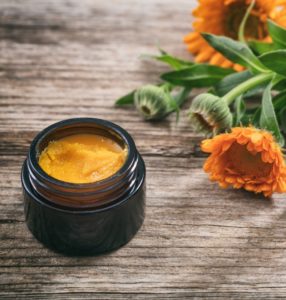Yeast vaginitis, aka vulvovaginal candidiasis, is the second most common vaginal infection in women. The most common is bacterial vaginosis. The infection most often causes discharge and itching of the local area. Candida albicans is the most common species, but not the only species. This is relevant because in cases that are chronic or frequently recurring, or nonresponsive to treatment, a culture may identify one of the other non albicans species which may then require a different treatment that is more curative. Conventional treatments include over the counter miconazole (aka Monistat) vulvovaginal creams and clotrimazole (aka Lotrimin) cream or prescription oral fluconazole capsules, prescription Nystatin cream, and boric acid capsules and herbal medications. Fluconazole can have some digestive side effects in some individuals and some of the creams can cause an allergic reaction.
 One of the topical herbal products to consider is calendula. Calendula flower extract has exhibited some antifungal properties in laboratory studies. The current triple-blind, randomized, controlled trial compared the effects of calendula vaginal cream to clotrimazole vaginal cream in treating vaginal candidiasis.
One of the topical herbal products to consider is calendula. Calendula flower extract has exhibited some antifungal properties in laboratory studies. The current triple-blind, randomized, controlled trial compared the effects of calendula vaginal cream to clotrimazole vaginal cream in treating vaginal candidiasis.
The study included 150 married, nonpregnant, reproductive aged women who were diagnosed with vaginal candidiasis both clinically and laboratory confirmed.
Calendula flowers were used in an extract concentration in a cream of 1%. The clotrimazole cream was also 1% strength. Women were instructed to use 5 g of vaginal cream each night before going to bed, and to refrain from using vaginal douches or other vulvovaginal creams and any systemic herbs or medications that could have an antifungal effect. Clinical symptoms, physical exam and laboratory assessments were done at baseline and on days 10-15 and again about one month after starting the treatment. Sexual function was also assessed using the female sexual function index (FSFI) at baseline.
There were 75 women in each group; five patients in the calendula group and one in the clotrimazole group did not attend the follow-up visits and were discontinued from the study. One patient in the calendula group reported minor increased itching, and another reported minor increased irritation for one day. In the clotrimazole group, one woman reported minor skin redness around the vulva for three days.
At visit one of follow-up, the proportion of women who were negative for Candida was 74% in the clotrimazole group and 49% in the calendula group. But at visit two, the calendula group that was negative was 77% of the women vs. 34% in the clotrimazole group. Of those with a negative result at visit one, 15% in the calendula group and 55% in the clotrimazole group had positive results at visit two. Of those with positive results at visit one, 69% in the calendula group and no one in the clotrimazole group had negative results at visit two.
The initial most frequent symptoms were vaginal discharge (83%) and vulvar pruritus (80%). At visit one, all symptoms were significantly reduced in both groups. At visit two, the frequency of vaginal discharge, vulvar itching, and irritation were significantly lower in the calendula group compared with the clotrimazole group. At visit one, the frequency of clinical signs on physical exam had reduced significantly and almost equally in both groups; However, excessive discharge, was more frequent in the calendula group. At visit two, the frequency of all clinical exam signs except localized inflammation, was lower in the calendula group compared. The mean FSFI score significantly increased in both groups similarly at visit two.
Commentary: Calendula cream appeared to be effective in the treatment of vulvovaginal candidiasis, although it took longer than the clotrimazole treatment. My thinking would be perhaps I would use both treatments for the first 10 days, and then continue on with the calendula cream only, for the next 20 days. The long term effects of the calendula cream were not assessed because if they still had positive laboratory findings at visit two, those women were treated with conventional medical treatment. One other important limitation of the study is the lack of identification of the Candida species.
Reference: Saffari E, Mohammad-Alizadeh-Charandabi S, Adibpour M, Mirghafourvand M, Javadzadeh Y. Comparing the effects of Calendula officinalis and clotrimazole on vaginal candidiasis: a randomized controlled trial. Women Health. November-December 2017;57(10):1145-1160

